Are You A Vanguard? Applications Now Open
The escalators at the entrance to the South Ferry subway station are completely submerged by floodwaters during Superstorm Sandy in October 2012.
Credit: MTA New York City Transit
This is your first of three free stories this month. Become a free or sustaining member to read unlimited articles, webinars and ebooks.
Become A MemberThis summer, the Metropolitan Transit Authority made a decision both small and remarkable in one of the New York City neighborhoods most vulnerable to climate change.
The city’s public transit agency, commonly known as the MTA, rerouted the Q114 bus along the Jamaica-Far Rockaway line in Queens. The reason given at the time of the service change? “Because of frequent tidal flooding on Brookville Boulevard,” a main drag that cuts through the saltwater marsh of Idlewild Park before stretching south toward the mouth of Jamaica Bay.
This small shift was noteworthy in being the first longterm route change within the MTA’s sprawling bus and subway system that was caused by an effect of climate change: frequent “sunny day” flooding into low-lying coastal land.
The decision was unique, but can be traced back 12 years to 2007, when climate started affecting the MTA in ways the agency couldn’t ignore. Following a nor’easter that August, in which precipitation flooded the underground subway system, the agency installed raised flood grates to push water away from vulnerable subway areas and into sewage canals. “Those were pretty much the first manifestations — physically, you could start to see — that the MTA was beginning to incorporate resilience into its planning and design,” says Projjal Dutta, director of sustainability initiatives for MTA.
Dutta was just starting his job as the agency’s first-ever sustainability director. Since then, he witnessed the entire system crippled by Superstorm Sandy, requiring a major recovery that continues seven years after the storm. He stayed on as the MTA faced a worsening fiscal crisis alongside a rapidly deteriorating system — major challenges that are far from resolved. And he remains as climate continues to transform New York public transit, both by threatening the system and placing the utmost importance upon it.
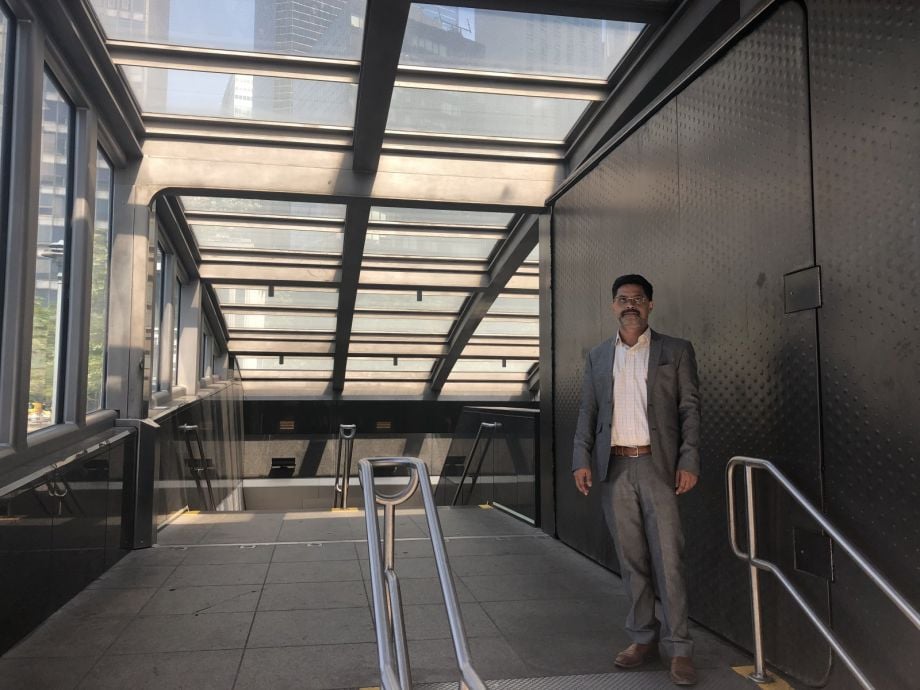
Projjal Dutta, director of sustainability initiatives for the MTA, stands in front of one of his resiliency efforts at a Manhattan subway station. (Photo by Emily Nonko)
During this period Dutta’s viewpoint has been more or less unchanged: that the MTA is one of the strongest assets combating climate change in the city, region, state and country — and that asset could be monetized so that it thrives into the future. The timing could not be more urgent for the MTA, or for the planet. The agency’s viability rests on what happens in the next few years, as it unrolls a $54-billion capital program, at the same time the Intergovernmental Panel on Climate Change announced that emissions worldwide need to peak by 2020, to avoid the worst devastations of climate change.
“We are in the sustainability business, more than many others,” Dutta says of the MTA. It’s something he suspects the public, even his own agency, doesn’t fully recognize. “New York State has the lowest per capita greenhouse gas emissions of all the United States,” he continues, “And New York State is the lowest because two-thirds of the state lives in MTA territory.”
In the early 2000s, scientist Klaus Jacob started studying the effects of climate change on New York City infrastructure. He approached major transit agencies in the region, like the MTA and Port Authority, seeking collaboration and access to relevant data.
“The MTA was very reluctant,” he says, “Because, as always, they were under financial stress. They said: if we know we have certain problems, then we have to do something about it. It’s one more thing on our plate we just can’t cope with right now.”
Jacob moved ahead on his research without them. A special research scientist with Columbia University’s Lamont-Doherty Earth Observatory, he sent students to subway platforms with barometers to measure the elevation and depth distribution of the tunnels. They modeled how water would rush into the system in an 100-year-storm: “We had preliminary results of what would happen and made a presentation to the MTA, asking, ‘Are you concerned about this?’”
Jacob found out the MTA had started an internal investigation of its own, regarding the vulnerability of its rolling stock (subway cars, some not in use) located in low-lying train yards. (The Transit Complex at Coney Island, one of the largest transportation facilities in North America, is at increasing risk to both flooding and sea-level rise.)
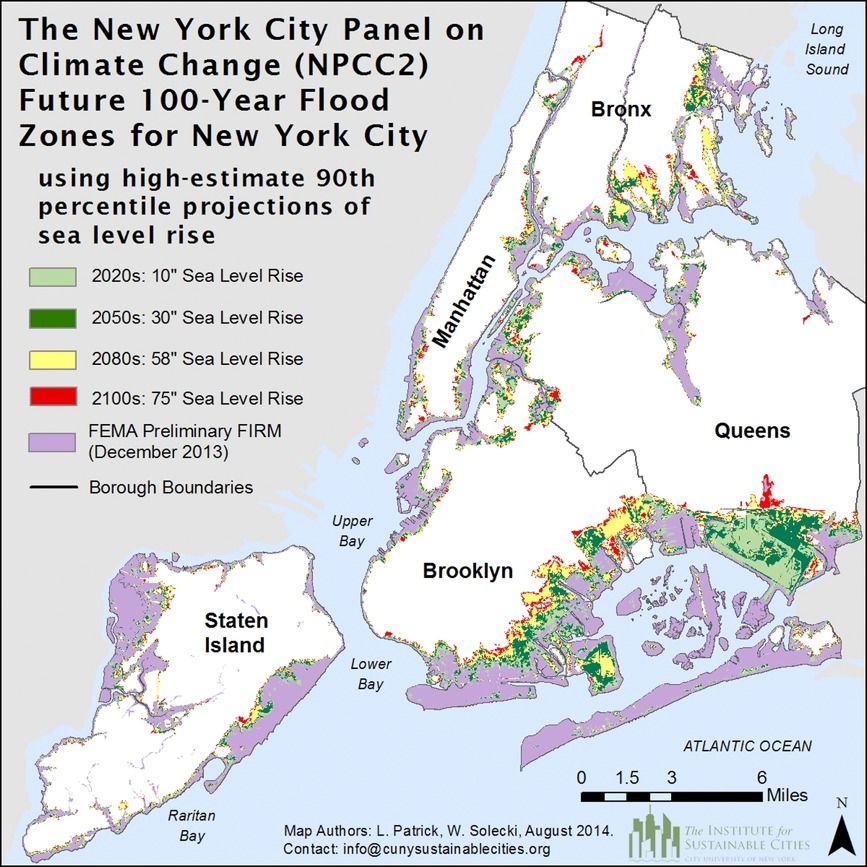
Potential areas that could be affected by the 100‐year flood in the 2020s, 2050s, 2080s, and 2100, based on NPCC2 projections of the high‐estimate 90th‐percentile sea level rise scenario. (Credit: New York City Panel on Climate Change 2015 Report)
Jacob says their interaction opened the door for increased communication, and collaboration, around climate risk. He released a report in conjunction with the agency in 2008, MTA Adaptations to Climate Change: A Categorical Imperative. In it he urged (in italics), “The climate-induced change of the physical environment necessitates that MTA find an effective way to adapt its infrastructure, operations, and policies.” In a 2011 report with the New York State Energy Research and Development Authority, Jacob found that “in a generic 100-year-storm, the subway system would flood within 40 minutes,” he recalls. “These results set off alarm clocks for the MTA.”
The August 2007 nor’easter, followed by Hurricane Irene in 2011, were troubling object lessons in how stormwater could flood the system. Superstorm Sandy arrived in 2012 as the wake-up call, filling stations and tunnels with gallons of corrosive saltwater that devastated the system. In a Herculean feat, the MTA restored 80 percent of the subway system within five days.
Sandy marked a dramatic turning point for the MTA and rest of New York. It exposed not just the vulnerabilities of public transit, but how essential a functioning system is to the city. (Jacob estimates that restoring service within a week, versus a month, saved the New York City economy “tens of billions of dollars.”)
Climate resilience has always been a part of Dutta’s role at the MTA, but after Sandy people started paying more attention. “It’s very often the case that when the first bits of disaster happen, that’s when people finally take action,” he says. “Sandy ups the response. First is to restore service at any cost, and once that is done, figure out how we will deal with the next storm.”
Sandy also prompted a necessary component for recovery and future resiliency: funding. The MTA secured roughly $5 billion of federal money for its “fix and fortify” initiative, a monumental effort that is ongoing. “It’s layers of work … a system-wide effort at different levels [of the agency],” explains Steven Loehr, recovery and resiliency manager with NYC Transit.
“You’re asking a current generation of cash-strapped engineers to spend money, whose main benefit will be reaped by kids who have not yet been born. … Those things, I think, need a philosophical and political resetting that you can’t expect an engineer or architect to deliver.”
Above: The South Ferry subway station was submerged by seawater flooding during Superstorm Sandy in October 2012. (Credit: MTA New York City Transit/Leonard Wiggins)
The biggest initiative, according to Loehr, has been identifying, then protecting, thousands of vulnerable access points for floodwaters to reach the underground subway system: stairs, vent bays, hatches, manholes, duct entries, elevators, escalators. (A 2016 Village Voice article delved into the effort required to “plug a million holes.”) The MTA has protected about two-thirds of access points in flood zones, according to Loehr, and expects to complete the work prior to the 2021 hurricane season.
Beyond the obvious Sandy repairs — rebuilding damaged stations, repairing flood-damaged signals and underwater tubes, like the L train tube work now underway — the storm inherently changed agency operations. “We have a very detailed hurricane plan … the challenge is we have to protect our infrastructure while also serving as an evacuation route,” Loehr explains. “Our plan entails thousands of tasks, things to be done a week in advance, then a phased response [as the hurricane nears].”
Carrying it out will require “unprecedented, monumental effort” from thousands of employees across the agency, Loehr says. Addressing the next storm is offset by a larger challenge: namely, figuring out what resilience looks like for the MTA in the age of climate change — a timeline stretching to 2100 and beyond — and how the cash-strapped agency will fund it.
“[Federal] dollars are like insurance money — but I think climate change is ongoing,” says Dutta. “Insurance money makes it feel like it was a one-off, like there was a break-in. But the thing is, nature is going to break in again and again.”
The MTA formed a Climate Adaptation Task Force in 2013, about a year after Sandy. In 2017 the agency released its first report with two statements that qualified the importance and threat of the system in the age of climate change.
The first statement, which Dutta has long proselytized, was that the region needs the MTA to effectively combat climate change. “Fortifying the MTA system against extreme weather plays a double role in regional climate adaptation,” the report states. “By increasing mass transit options through capital expansions and aggressively reducing its vehicle and facility emissions, the MTA continuously mitigates the local accelerators of climate change.”
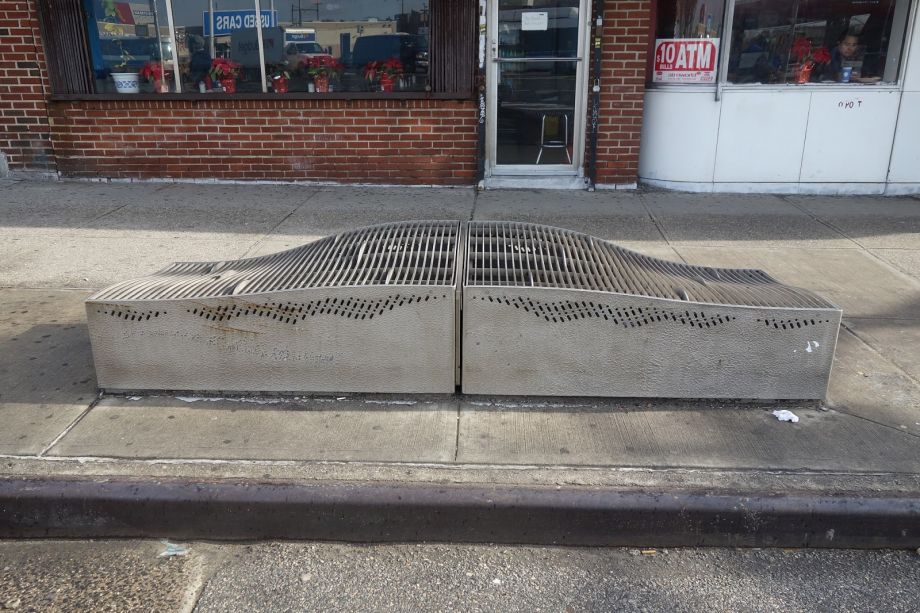
Elevated ventilation grates, some more stylized than others, are one of the MTA resiliency efforts designed to prevent flooding in the subways. This one is at the Northern Boulevard station in Woodside, Queens. (Photo by Tdorante10 via Wikimedia Commons)
The second was that “due to aging infrastructure and vulnerable assets … climate change disproportionately impacts the MTA.” The report breaks down how the realities of the climate crisis — sea-level rise, coastal storm surge, extreme winds, temperature rises and heat waves, and heavy precipitation — will all negatively affect MTA service. New York faces a future in which storm surges will superimpose upon ever-rising sea levels, wearing down the city’s infrastructure at a pace increasingly difficult to recover from.
It’s a frightening future, but the report came at a time of public outrage over day-to-day service, prompting Governor Andrew Cuomo to declare a “state of emergency” for the subway. As the New York Times and local news outlets churned out coverage of 2017’s “drumbeat of transit disasters,” it was clear the MTA faced a financial, service and management crisis.
The immediate needs to address at the MTA result in difficult questions when it comes to long-term climate planning — particularly when the agency is limited to federal disaster funding. Dutta paints a hypothetical picture of an engineer elevating a sub-station along the MetroNorth rail line, which hugs the Hudson River: “You could raise it 10 feet, and you think that’s pretty good for 2050, or you could raise it 20 feet, which would take you clear up to 2100,” he says. “But there’s a price differential. And you’re asking a current generation of cash-strapped engineers to spend money, whose main benefit will be reaped by kids who have not yet been born.”
“This is a real intergenerational transfer,” he continues, “And those things, I think, need a philosophical and political resetting that you can’t expect an engineer or architect to deliver.”
Loehr explains the MTA’s resiliency efforts are set to a high standard: all projects meet or exceed the Federal Transit Administration’s requirement of protection against FEMA’s 100-year storm levels, plus one foot. Still, the agency grapples with questions of resiliency investments in flood-vulnerable areas. “We have to optimize the risk with the benefit versus the cost, and find the right level to land on,” says Loehr.
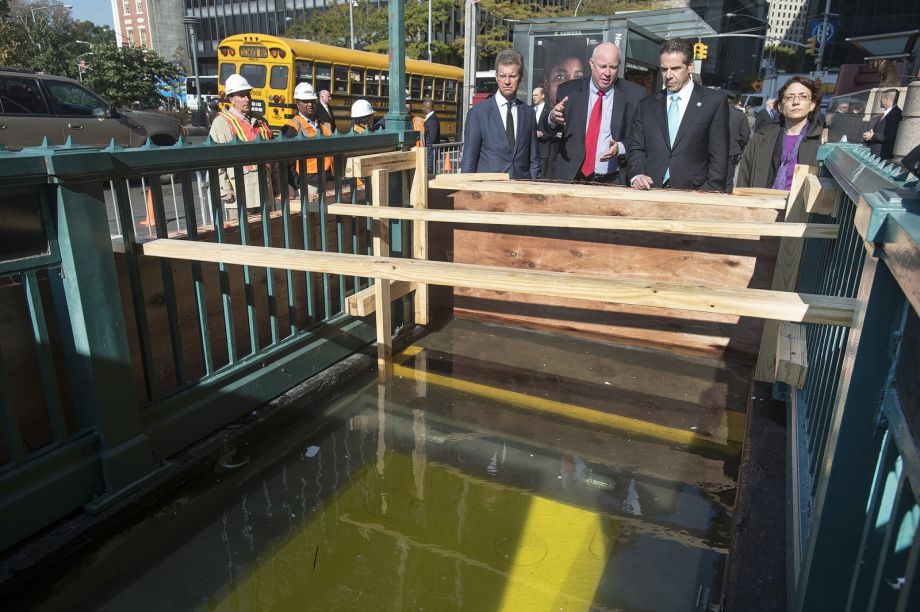
On the first anniversary of Superstorm Sandy, MTA Chairman & CEO Thomas Prendergast, then-HUD Secretary Shaun Donovan and Gov. Andrew Cuomo inspect a removable flood-control cover for stairs at the Whitehall Street subway station. (Credit: MTA / Patrick Cashin)
One example is the Rockaways, where the MTA rerouted the Q114 bus. The neighborhood is one of the most vulnerable in the city, bordered by Jamaica Bay and the Atlantic Ocean. Sandy devastated the Rockaway subway line, which stretches across the bay. “To keep the entire line dry, we’d need to build walls many feet into the air through environmentally sensitive areas,” Loehr says. “But our goal is to protect that right-of-way and restore service as quickly as possible after a storm, and there are more cost effective ways to do that.”
While protections such as flood barriers will take the MTA through the next few decades, the New York City Panel on Climate Change anticipates a six-foot, three-inch sea level rise in the early part of the next century. That will leave most of the Rockaway peninsula underwater, with neighborhoods like Coney Island — home to the MTA’s Transit Complex — and Lower Manhattan — the nexus of many subway lines — at risk of permanent flooding.
This is a crisis far beyond the MTA, Jacob believes. Flood-proofing at-risk subway lines makes little sense in neighborhoods no longer viable to live and work in: “there’s no point in having a transportation system if it doesn’t serve anybody,” as he puts it.
“It’s not that the city has been complacent, it’s that we have short- and mid-term solutions,” Jacob continues. “People think 2100 is so far down the line, but we have to install new infrastructure systems constantly that have a lifetime of 100 years or more. We’re investing, in a way, with no vision how investments of today will function in a context of flood level and sea level rise in 2100.”
In September 2019, more than 250,000 people, mostly youth, flooded Lower Manhattan for the New York City Climate Strike. A few months prior New York State passed a bill with the most ambitious climate targets in the country; protesters called for even greater action.
For Dutta, it’s as good of a time as any to repeat a longstanding argument, which he’s managed to integrate in most literature about how New York combats climate change. It’s that annually, the MTA avoids 19 million metric tons of greenhouse gases, while the system only emits two metric tons, resulting in a net avoidance of 17 million metric tons per year.

Left: Damage on the New York City Subway’s Rockaway Line (A train). October 30, 2012. (Credit: MTA New York City Transit / Leonard Wiggins) Right: Phase 2 of Rockaways Long-Term Flood Protection work nears completion at Hammels Wye in August 2018. (Credit: Marc A. Hermann / MTA New York City Transit)
It can be hard for a New Yorker dealing with daily commuting frustrations to take a bird’s eye view of the system. But the MTA is the lifeblood not just of the city, but a regional commuting network that includes MetroNorth, Long Island Railroad and New Jersey Transit. This integrated system of commuter rails, subway lines and buses supports one of the largest world economies while getting millions of people out of cars — a monumental environmental feat given that the U.S. transportation sector generates the largest share of greenhouse gas emissions.
Dutta also argues that “transit avoided carbon,” the term used within the sustainability office, is the backbone for a carbon-efficient lifestyle. Public transit, for example, facilitates housing density, which combats climate change. It supports a walkable city, eliminating short car rides in a country where one-third of trips are less than two miles. It contributes to the success of alternative transit modes such as bike share.
“Carbon avoidance was not a part of the lexicon when I showed up,” Dutta says. “But now, what we have to do is try to monetize this.”
Dutta believes one of the most promising funding streams for the MTA could be a federal carbon market, a tool aimed to reduce greenhouse gas emissions by setting limits on emissions and enabling the trading of emission units. “If we could sell this, get compensation for this fundamental service we provide the city, the country, the world, we could get a lot of money,” he says.
Dutta envisions a market in which carbon sells at $30 per ton, the rate proposed by the 2009 Waxman-Markey bill. (The bill passed in the House and was never voted on in the Senate; it’s still credited for sowing the seeds for other climate efforts.) So what would it mean for the MTA to actually sell its 17 million metric tons of greenhouse gas avoidance? “That’s a $510 million environmental good that we produce, that is not recognized, verified, measured, compensated or anything,” says Dutta. “But we produce it.”
He’s not alone in looking to the potential of a carbon market. The European Union established a cap-and-trade system in 2005; and a patchwork of state and regional markets has emerged across North America. The New York State Energy Research and Development Authority launched a Transportation and Climate Initiative in 2010, with a mission to reduce greenhouse gas emissions from transportation in northeastern states. The initiative is developing a regional, low-carbon transportation policy proposal, with a draft expected to wrap this year. A cap-and-trade program would be a main component of the policy, according to an October report.
Transit advocates — who’ve been on the front lines fighting for day-to-day service improvements — are paying attention. “Our hope is that some of the billions of dollars raised from the sale of fossil fuels will support the balance sheet of the MTA, which needs a jaw-dropping amount of money to fix and operate the subway well,” says Danny Pearlstein, policy and communications director for transit advocacy organization Rider’s Alliance.
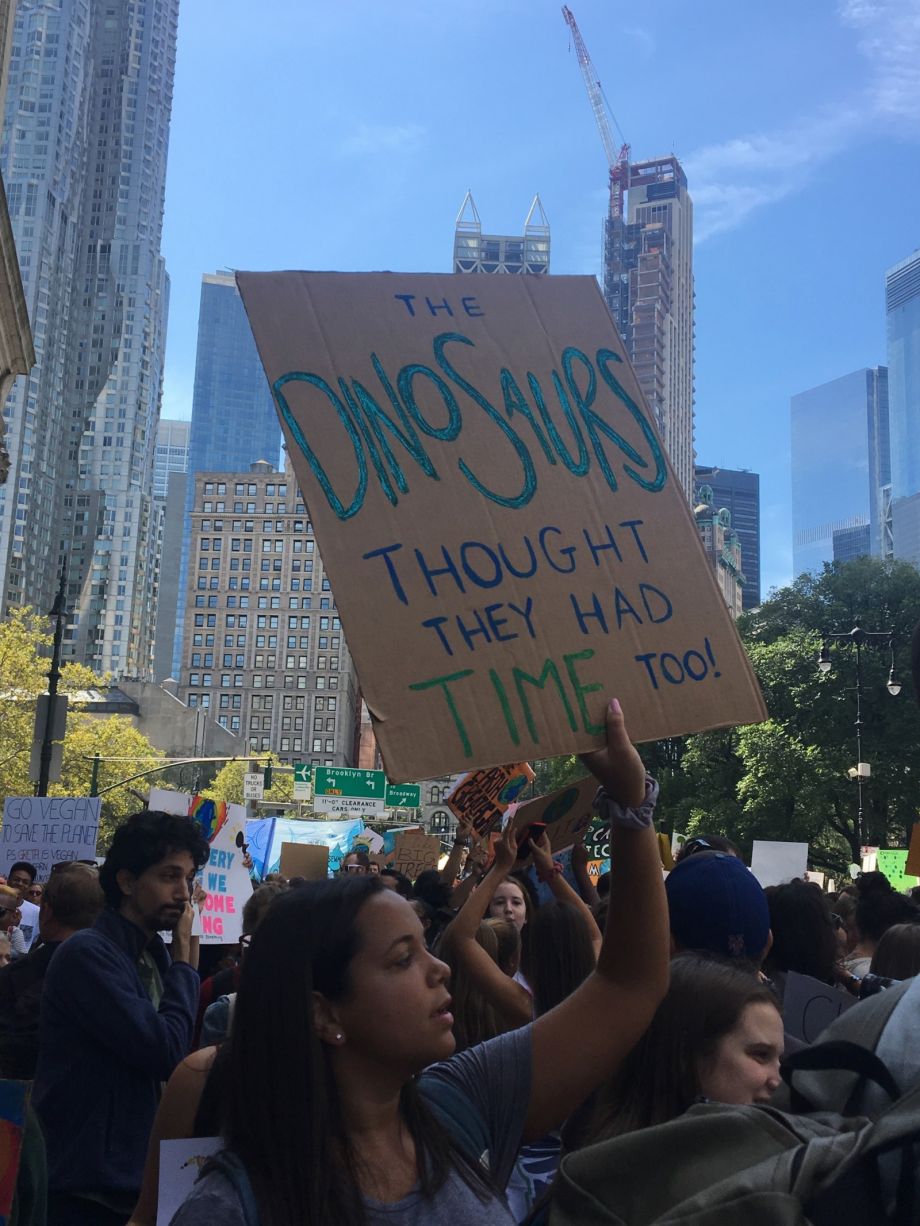
Protest sign at Global Climate Strike in NYC, September 2019. (Credit: Rainmaker Photo/MediaPunch /IPX)
Reliable public transit, he adds, is critical as climate increasingly threatens New York — both to protect existing riders against effects such as heat and flooding, and to encourage more people out of cars and onto trains and buses. “New York City is light-years ahead with a comprehensive transit system people depend on,” Pearlstein says. “If we can make it much better, we can reduce the carbon footprint, improve a rider’s quality of life and improve the economy. Then we can use funding from the proposal to tax carbon to bolster the quality of transit even further.”
During the wait for a carbon market, Dutta’s office is moving ahead with other measures to monetize the MTA through sustainability. This Earth Day, the agency released a request for proposals to begin leasing its millions of square feet of industrial roof and parking lot space to solar companies. The agency received 46 proposals for seven sites, with rent proposals twice as high as Dutta expected. “If every last solar opportunity were exploited by the MTA,” he says, “We’d anticipate an approximate rental income of $250 million over a 20-year period.”
In late September, the MTA’s board unanimously approved a $51.5-billion capital spending plan. Just $25 billion of the plan is guaranteed through dedicated revenues, such as taxes and tolls from Manhattan’s forthcoming congestion pricing, so the agency will have to fight to secure money from city, state and federal administrations. (The majority of federal transit funding goes to roadways and highways, leaving limited resources for public transit across the U.S.) A carbon market isn’t part of any MTA funding proposal, but a major tenet of the overall plan is “increased environmental sustainability and resiliency.”
Investment priorities like modernized signals, accessibility, infrastructure repairs and fleet improvements — including 500 new zero-emission, all-electric buses — are all essential. But a call for electric buses doesn’t scrape the surface of how deeply climate will affect the MTA. And while the capital report highlights those 17 million metric tons of carbon the system offsets, it doesn’t frame this ambitious proposal as an urgent necessity of the climate crisis. It feels like a lost opportunity, in light of how transit advocates, politicians and citizens increasingly declare that public transit and climate are inextricably linked.
There are hurdles and questions ahead, a new chapter in Dutta’s role overseeing sustainability at the MTA. Much has changed since he started 12 years ago and the agency was just integrating resiliency into service. But he feels hopeful of what’s ahead: “In some sense, there is a new day at the MTA.” Dutta goes back in time, to the incredible span of New York history when its subway system grew from a single line in 1904 to a network hundreds of miles long by the 1920s. “When they started building, they knew they were building for the future … it’s a mindset.”
“I’m submitting,” he continues, “that this is as good a time as any — with climate change, with the MTA in need of a once-in-a-generation capital infusion — to be having these talks and building for the future.”

Emily Nonko is a social justice and solutions-oriented reporter based in Brooklyn, New York. She covers a range of topics for Next City, including arts and culture, housing, movement building and transit.
Follow Emily .(JavaScript must be enabled to view this email address)

20th Anniversary Solutions of the Year magazine